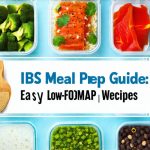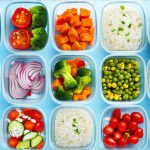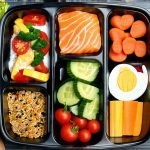Living with Irritable Bowel Syndrome (IBS) often means navigating a complex relationship with food. The unpredictability can be exhausting – one day a seemingly harmless meal is fine, the next it triggers debilitating symptoms. Many people with IBS find themselves constantly anxious about what they’re going to eat, and even more stressed about preparing meals that won’t cause discomfort. This anxiety often leads to restrictive diets, social isolation around food, and an overall decrease in quality of life. But it doesn’t have to be this way! With a little planning and understanding of your personal triggers, you can reclaim control over your diet and enjoy eating again.
The key is proactive meal preparation. Spontaneous lunches often lead to hasty decisions that can derail even the most disciplined IBS-friendly eater. By dedicating just one hour each week to prepping lunches, you’re not only setting yourself up for a symptom-free workweek but also saving time, money, and mental energy. This isn’t about complicated recipes or restrictive diets; it’s about building a system that supports your digestive health and simplifies your life. We’ll focus on creating flexible lunch components that can be mixed and matched to avoid boredom and accommodate changing needs, all while adhering to common IBS-friendly principles like the low-FODMAP diet (though this is just a starting point – personalize it!). If you’re struggling with unexpected symptoms, understanding gut diversity can also be very helpful.
Building Your IBS Lunch Prep Foundation
The cornerstone of successful IBS meal prep is understanding your individual triggers. What foods consistently cause you problems? Keep a food diary for a week or two to identify patterns. Are beans problematic? Does lactose bother you? Once you know what to avoid, building your lunch prep becomes much easier. Focus on incorporating safe and well-tolerated ingredients into your weekly plan. This might include things like cooked quinoa, rice noodles, grilled chicken or fish, steamed vegetables (carrots, spinach, zucchini), hard-boiled eggs, lactose-free yogurt, and fruits low in fructose (berries, bananas – in moderation). Remember: personalization is paramount. What works for one person with IBS may not work for another. If you struggle to navigate social settings while managing your gut health, learning how to handle a sensitive stomach can be incredibly beneficial.
Another crucial aspect of this foundation is thinking in terms of components rather than complete meals. Instead of preparing five fully assembled lunches, we’ll focus on prepping individual elements that can be combined in various ways throughout the week. This offers flexibility and prevents monotony. For example, you might cook a large batch of quinoa, roast some chicken breast, steam broccoli, and slice up some cucumber. Then, each day, you can create a different lunch combination using these ingredients – a quinoa salad with chicken and cucumber, or chicken and broccoli over rice noodles. This approach significantly reduces the feeling of being stuck with the same meal every day. Building a weekly digestive health routine can help you stay on track and consistent.
Finally, invest in good quality airtight containers. This is essential for keeping your prepped food fresh and organized throughout the week. Glass containers are ideal as they don’t absorb odors or stains, but BPA-free plastic containers work well too. Portioning out your ingredients into individual lunch boxes or containers during prep makes assembling your lunches even faster each morning.
Assembling Your Weekly Shopping List & Prep Schedule
A well-structured shopping list is the first step towards a successful prep session. Base your list on your identified safe foods and the components you plan to prepare. For example:
* Protein: Chicken breast, salmon fillets, firm tofu (if tolerated)
* Grains/Starches: Quinoa, rice noodles, brown rice, gluten-free bread
* Vegetables: Carrots, spinach, zucchini, cucumber, bell peppers
* Fruits: Blueberries, strawberries, bananas (in moderation), oranges
* Healthy Fats: Avocado, olive oil, nuts and seeds (check for FODMAP content)
* Other: Lactose-free yogurt, gluten-free soy sauce/tamari
Once you have your list, create a prep schedule. This doesn’t need to be overly detailed, but having a general plan will keep you on track. Allocate about 10 minutes for each component: 20 minutes for protein (marinating and cooking), 15-20 minutes for grains/starches, and 25 minutes for vegetables (washing, chopping, steaming/roasting). This leaves some buffer time for assembling everything into containers. Consider what order will be most efficient – for example, while the chicken is marinating, you can start washing and chopping vegetables.
Optimizing Your Prep Time
Efficiency is key when aiming to prep a week of lunches in just one hour. One strategy is batch cooking – preparing large quantities of staple ingredients that can be used in multiple meals. For instance, cook a whole bag of quinoa at once rather than just enough for one lunch. This saves time and effort in the long run. Another tip is to utilize pre-cut vegetables when possible (though they tend to be more expensive). If you have a food processor or mandoline slicer, use them to quickly chop vegetables – but always prioritize safety!
Don’t underestimate the power of mise en place – a French culinary term that means “everything in its place.” Before you start cooking, gather all your ingredients, utensils, and containers. This will streamline the process and prevent mid-prep interruptions. Finally, clean as you go. Washing dishes or wiping down surfaces between tasks keeps your workspace organized and prevents a massive cleanup at the end. If you’ve had a particularly difficult flare up, consider building a recovery meal to help soothe your system.
Building Variety into Your Prep
IBS can be incredibly restrictive, but it doesn’t have to mean bland and boring lunches. Even with limited options, you can create variety by focusing on different flavor combinations and textures. Experiment with herbs and spices (avoiding those that trigger your symptoms) to add depth and complexity to your meals. Consider adding a small container of chopped nuts or seeds for crunch, or a drizzle of olive oil for healthy fats.
Think about the presentation of your lunches too. A visually appealing lunch is more enjoyable to eat. Use colorful vegetables, arrange ingredients artfully in your containers, and pack everything securely to prevent spills. Consider adding a small side dish like a few berries or a handful of gluten-free crackers to round out your meal. When navigating relationships while living with IBS, learning how to handle a sensitive gut can ease anxieties and improve communication.
Assembling Your Lunch Components: Examples & Ideas
Here are some examples of lunch components you can prep each week:
* Protein: Grilled chicken breast (seasoned with herbs and spices), baked salmon, hard-boiled eggs, firm tofu cubes
* Grains/Starches: Cooked quinoa, brown rice, gluten-free pasta or noodles
* Vegetables: Steamed broccoli, roasted carrots, sliced cucumber, spinach salad (with a simple olive oil and lemon juice dressing)
* Fruits: Blueberries, strawberries, orange slices
* Dressings/Sauces: Homemade vinaigrette (olive oil, lemon juice, herbs), lactose-free yogurt dip
With these components, you can create countless lunch combinations. For example:
* Quinoa with grilled chicken and steamed broccoli
* Salmon with brown rice and sliced cucumber
* Spinach salad with hard-boiled egg and blueberries
* Tofu cubes with gluten-free noodles and roasted carrots
Remember to personalize these suggestions based on your own dietary needs and preferences. The goal is to create a system that works for you.
This method isn’t just about preparing food; it’s about taking control of your health and well-being. It’s about removing the anxiety surrounding lunchtime, freeing up time and energy, and ultimately enjoying your meals without fear of triggering symptoms. By investing one hour each week in thoughtful preparation, you can significantly improve your quality of life with IBS. You could also consider how to prep a gut-friendly lunchbox for work or school!


















